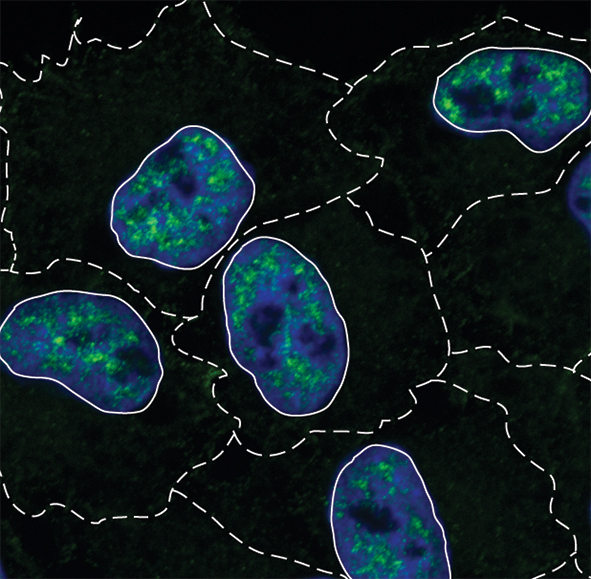‘Bodyguard’ Protein Helps Protect Young RNAs

The newly identified protein NCBP3 (marked in green) at work in the nucleus of the cell (marked in blue). The dotted lines are showing the shape of the cells. Picture: Andreas Pichlmair / Copyright: MPI of Biochemistry
Scientists from the Max Planck Institute of Biochemistry (MPIB) in Martinsried have now identified a new mechanism that stabilizes specific RNA molecules and guides their processing. “The molecular complex associated with the protein NCBP3 we identified is primarily important in cellular stress situations such as virus infections,” says Andreas Pichlmair, group leader at the MPIB. “Our findings may open up new therapeutic approaches in the future.”
RNA molecules with defects are rapidly degraded before they can harm the cell. To prevent nascent, still functionless RNA molecules from being destroyed already during RNA synthesis, they are provided with a molecular “cap” to protect them. The vulnerable end of the RNA molecule is thus masked, causing it to evade the cellular waste disposal mechanism.
A “cap-binding complex” (CBC) binds to this cap, thus stabilizing it. The CBC also fulfils other tasks: It regulates the processing of the RNA molecules, which includes the removal of unneeded regions. An important step for mRNAs, which transmit genetic information, is the export from the nucleus of the cell. mRNAs can only serve as blueprints for proteins if they are outside the nucleus, in the cytoplasm.
Until now, the prevailing scientific consensus was that the CBC consists exclusively of two “nuclear cap-binding proteins” (NCBP1 and 2), which bind in tandem to the cap-bearing end of the relevant RNA. Both NCBPs were considered essential for processes such as mRNA export from the cell nucleus. But as the current study shows, a loss of NCBP2 neither restricts this process nor is it harmful to the cell.
“We were able to identify an additional protein that occurs in conjunction with NCBP1, which we named NCBP3,” says Andreas Pichlmair. This protein is found in most higher organisms and is highly conserved in its structure, that is, it is scarcely varied – which suggests that its function is essential.
The conventional cap with NCBP2 is mainly associated with mRNAs and small RNAs. By contrast, the newly discovered complex only occurs with mRNAs that require intensive further processing. In addition, it is particularly important when the cell is stressed – for example, in virus infections. The researcher hopes this finding will open up new therapeutic approaches. It is also significant that the CBC associated with NCBP3 may possibly play a role in diseases that are due to defective RNA processing.
Further studies will now show whether and in what form NCBP3 is involved in anti-virus protection and in the development of diseases. It is already certain that the biogenesis of RNA molecules and thus one of the central processes of the cell is far more complex than previously assumed and is also controlled by external influences.
Original Publication
A. Gebhardt, M. Habjan, C. Benda, A. Meiler, D. Haas, M. Hein, A. Mann, M. Mann, B. Habermann and A. Pichlmair: NCBP3, a cap-binding protein involved in mRNA biogenesis. Nature Communications, September 18, 2015
DOI: 10.1038/ncomms9192
Contact
Dr. Andreas Pichlmair
Innate Immunity
Max Planck Institute of Biochemistry
Am Klopferspitz 18
82152 Martinsried
e-mail: apichl@biochem.mpg.de
http://www.biochem.mpg.de/pichlmair
Dr. Christiane Menzfeld
Public Relations
Max Planck Institute of Biochemistry
Am Klopferspitz 18
82152 Martinsried
Phone: +49 89 8578-2824
e-mail: pr@biochem.mpg.de
http://www.biochem.mpg.de
http://www.biochem.mpg.de/news – further press releases of the MPI for biochemistry
http://www.biochem.mpg.de/pichlmaier – website of the research group “Innate Immunity” (Andreas Pichlmair)
Media Contact
All latest news from the category: Life Sciences and Chemistry
Articles and reports from the Life Sciences and chemistry area deal with applied and basic research into modern biology, chemistry and human medicine.
Valuable information can be found on a range of life sciences fields including bacteriology, biochemistry, bionics, bioinformatics, biophysics, biotechnology, genetics, geobotany, human biology, marine biology, microbiology, molecular biology, cellular biology, zoology, bioinorganic chemistry, microchemistry and environmental chemistry.
Newest articles

First-of-its-kind study uses remote sensing to monitor plastic debris in rivers and lakes
Remote sensing creates a cost-effective solution to monitoring plastic pollution. A first-of-its-kind study from researchers at the University of Minnesota Twin Cities shows how remote sensing can help monitor and…

Laser-based artificial neuron mimics nerve cell functions at lightning speed
With a processing speed a billion times faster than nature, chip-based laser neuron could help advance AI tasks such as pattern recognition and sequence prediction. Researchers have developed a laser-based…

Optimising the processing of plastic waste
Just one look in the yellow bin reveals a colourful jumble of different types of plastic. However, the purer and more uniform plastic waste is, the easier it is to…



